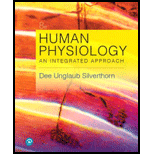
Human Physiology: An Integrated Approach Plus Mastering A&P with Pearson eText -- Access Card Package (8th Edition) (What's New in Human Physiology)
8th Edition
ISBN: 9780134701523
Author: Dee Unglaub Silverthorn
Publisher: PEARSON
expand_more
expand_more
format_list_bulleted
Question
Chapter 22.6, Problem 19CC
Summary Introduction
To determine: The use of sitagliptin in the treatment of diabetes.
Introduction: Diabetes is categorized into two types: type 1 and type 2 diabetes. Type 2 diabetes is insulin dependent diabetes. People who have diabetes have reduced the production of insulin in their body leading to a delayed response to ingested glucose. In some cases, both resistance to insulin as well as reduced secretion of insulin is seen.
Expert Solution & Answer
Want to see the full answer?
Check out a sample textbook solution
Students have asked these similar questions
State the five functions of Globular Proteins, and give an example of a protein for each function.
Diagram of check cell under low power and high power
a couple in which the father has the a blood type and the mother has the o blood type produce an offspring with the o blood type, how does this happen? how could two functionally O parents produce an offspring that has the a blood type?
Chapter 22 Solutions
Human Physiology: An Integrated Approach Plus Mastering A&P with Pearson eText -- Access Card Package (8th Edition) (What's New in Human Physiology)
Ch. 22.1 - Explain the roles of the satiety and feeding...Ch. 22.1 - Name the four layers of the GI tract wall,...Ch. 22.2 - Prob. 3CCCh. 22.2 - Prob. 4CCCh. 22.2 - Prob. 5CCCh. 22.2 - Prob. 6CCCh. 22.4 - Prob. 7CCCh. 22.4 - Prob. 8CCCh. 22.4 - Use your understanding of digestive physiology to...Ch. 22.5 - Prob. 10CC
Ch. 22.5 - Prob. 11CCCh. 22.5 - Prob. 12CCCh. 22.6 - What are the primary target tissues for insulin?Ch. 22.6 - Why are glucose metabolism and glucose transport...Ch. 22.6 - What is the advantage to the body of inhibiting...Ch. 22.6 - Prob. 16CCCh. 22.6 - Prob. 17CCCh. 22.6 - Prob. 18CCCh. 22.6 - Prob. 19CCCh. 22.6 - Prob. 20CCCh. 22.7 - Prob. 21CCCh. 22.7 - Prob. 22CCCh. 22.7 - Prob. 23CCCh. 22.7 - Prob. 24CCCh. 22 - Define metabolic, anabolic, and catabolic...Ch. 22 - Prob. 2RQCh. 22 - Prob. 3RQCh. 22 - Prob. 4RQCh. 22 - Define basal metabolic rate (BMR). Under what...Ch. 22 - Prob. 6RQCh. 22 - Prob. 7RQCh. 22 - What is a nutrient pool? What are the three...Ch. 22 - Prob. 9RQCh. 22 - Prob. 10RQCh. 22 - Prob. 11RQCh. 22 - Name the two hormones that regulate glucose...Ch. 22 - Which noncarbohydrate molecules can be made into...Ch. 22 - Under what circumstances are ketone bodies formed?...Ch. 22 - Name two stimuli that increase insulin secretion,...Ch. 22 - Prob. 16RQCh. 22 - What factors release glucagon? What organ is the...Ch. 22 - Prob. 18RQCh. 22 - Prob. 19RQCh. 22 - Prob. 20RQCh. 22 - Prob. 21RQCh. 22 - Prob. 22RQCh. 22 - Prob. 23RQCh. 22 - Prob. 24RQCh. 22 - Explain the current theory of the control of food...Ch. 22 - Prob. 26RQCh. 22 - Scott is a bodybuilder who consumes large amounts...Ch. 22 - Prob. 28RQCh. 22 - Prob. 29RQCh. 22 - One of the debates in fluid therapy for diabetic...Ch. 22 - Prob. 31RQCh. 22 - Prob. 32RQ
Knowledge Booster
Similar questions
- What is the opening indicated by the pointer? (leaf x.s.) stomate guard cell lenticel intercellular space none of thesearrow_forwardIdentify the indicated tissue? (stem x.s.) parenchyma collenchyma sclerenchyma ○ xylem ○ phloem none of thesearrow_forwardWhere did this structure originate from? (Salix branch root) epidermis cortex endodermis pericycle vascular cylinderarrow_forward
- Identify the indicated tissue. (Tilia stem x.s.) parenchyma collenchyma sclerenchyma xylem phloem none of thesearrow_forwardIdentify the indicated structure. (Cucurbita stem l.s.) pit lenticel stomate tendril none of thesearrow_forwardIdentify the specific cell? (Zebrina leaf peel) vessel element sieve element companion cell tracheid guard cell subsidiary cell none of thesearrow_forward
- What type of cells flank the opening on either side? (leaf x.s.) vessel elements sieve elements companion cells tracheids guard cells none of thesearrow_forwardWhat specific cell is indicated. (Cucurbita stem I.s.) vessel element sieve element O companion cell tracheid guard cell none of thesearrow_forwardWhat specific cell is indicated? (Aristolochia stem x.s.) vessel element sieve element ○ companion cell O O O O O tracheid O guard cell none of thesearrow_forward
- Identify the tissue. parenchyma collenchyma sclerenchyma ○ xylem O phloem O none of thesearrow_forwardPlease answer q3arrow_forwardRespond to the following in a minimum of 175 words: How might CRISPR-Cas 9 be used in research or, eventually, therapeutically in patients? What are some potential ethical issues associated with using this technology? Do the advantages of using this technology outweigh the disadvantages (or vice versa)? Explain your position.arrow_forward
arrow_back_ios
SEE MORE QUESTIONS
arrow_forward_ios
Recommended textbooks for you
- Essentials of Pharmacology for Health ProfessionsNursingISBN:9781305441620Author:WOODROWPublisher:Cengage
 Biology 2eBiologyISBN:9781947172517Author:Matthew Douglas, Jung Choi, Mary Ann ClarkPublisher:OpenStax
Biology 2eBiologyISBN:9781947172517Author:Matthew Douglas, Jung Choi, Mary Ann ClarkPublisher:OpenStax Human Physiology: From Cells to Systems (MindTap ...BiologyISBN:9781285866932Author:Lauralee SherwoodPublisher:Cengage Learning
Human Physiology: From Cells to Systems (MindTap ...BiologyISBN:9781285866932Author:Lauralee SherwoodPublisher:Cengage Learning BiochemistryBiochemistryISBN:9781305577206Author:Reginald H. Garrett, Charles M. GrishamPublisher:Cengage Learning
BiochemistryBiochemistryISBN:9781305577206Author:Reginald H. Garrett, Charles M. GrishamPublisher:Cengage Learning



Essentials of Pharmacology for Health Professions
Nursing
ISBN:9781305441620
Author:WOODROW
Publisher:Cengage

Biology 2e
Biology
ISBN:9781947172517
Author:Matthew Douglas, Jung Choi, Mary Ann Clark
Publisher:OpenStax

Human Physiology: From Cells to Systems (MindTap ...
Biology
ISBN:9781285866932
Author:Lauralee Sherwood
Publisher:Cengage Learning

Biochemistry
Biochemistry
ISBN:9781305577206
Author:Reginald H. Garrett, Charles M. Grisham
Publisher:Cengage Learning